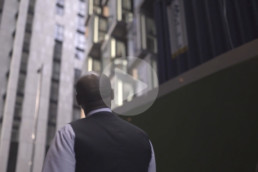At Maple People, we care more about using sustainable building materials and developing innovations in construction than simply designing aesthetically-pleasing office interiors. We put people first – specifically, the people who will be using the space long after our construction team have packed up and left. We believe that office spaces should be designed to enhance the wellbeing and performance of those who will use it for years to come.
For 40 hours a week, most offices are a hive of activity. The people that work in an office may not always notice, but design aspects such as lighting, temperature control, ventilation and the floor-plan itself can all have an impact on their wellbeing. A healthy worker is likely to work harder and perform better.
The quality of an office space can affect up to 10% of a business’ productivity, or the lack of. It is not difficult to do the maths to understand how thoughtful investment at first can look after the the business in the long term.
So, how can office designers ensure that their work contributes to the health and happiness of those that will use their space?
The risks of poor office design
There are many elements of the office design to consider when carrying out a Cat-A and B fit-out, particularly if you wish to create a space that does more than just look good. Here are some of the key features that could negatively affect a high-performing space.
Floor plans
There is a growing body of evidence to suggest that sitting down all day is worse for your health than smoking cigarettes, and that even those who exercise regularly are at risk if they don’t keep moving during the day. But what does this have to do with office design? Well, traditional offices are designed to ensure workers have everything they need within arms reach – so they barely have to leave their desks. And when they do, the important features of the office are repeated in each section to avoid long diversions.
Air quality and temperature
Low-quality air, over-reliance on air conditioning, poor temperature control, and lack of access to ventilation can all lead to health problems and fatigue. We have all experienced the 3 pm -slump on a summer afternoon, where the temperature is rising and the air in the office seems to stand still. This isn’t just bad for employee morale and health, but bad for their ability to be productive, too. And it’s not just the summer months where we can see this happen; cold winter mornings can make workers feel sluggish, too. That’s why the ability to control the temperature and the absence of hot or cold spots is vital in any working space. Research also suggests that the carbon dioxide levels in overcrowded/under-ventilated meeting rooms can contribute to reduced cognitive function – thankfully, only temporarily.
Lighting
Office lighting is something that most of us pay little attention to, but poor lighting and a lack of natural light can contribute to headaches, eye strain, tiredness, and even anxiety or depression. There is a wealth of research available to show that incorporating even a small amount of exposure to natural light into a working day can improve wellness through the release of endorphins, as well as improving the quality of sleep. While regulations state that lighting must be suitable and sufficient, there are no rules as to what exactly this means; it is down to office designers to take responsibility for upholding great standards instead of opting for the minimum requirement – or the cheapest, just because it looks great.
How to design office interiors for wellbeing and productivity
When we add these elements together, it becomes clear that planning your office design in advance is more efficient and sustainable than trying to retroactively address any areas in which the space falls short after construction.
For example, a well-designed, person-centric office space could see the amenities situated more than a short hop away from any desk, with meandering routes that bypass natural light sources to get workers moving and lift their spirits. Temperature control and ventilation that works effortlessly in the background help people to maintain focus without distraction and discomfort. It’s also vital to have a space that looks comfortable, with clean lines and without too much visual ‘noise’ – but that is the primary concern in most traditional office spaces. Today, Maple People and other responsible constructors incorporate that visual design with the need for happy and productive employees, too.
Share this article
If you are inspired to support sustainable design and either have the skills we are looking for, or a project that needs Maple People’s special expertise, please get in touch. We’d love to hear from you.
Saj Rahman
From way back when, I have always had a need to make others smile. Whether it’s family or a complete stranger, I found it to be something I am good at. Although troubling at first, I realised that it was a gift – and I decided to embrace it. Here’s how that led to Maple People.
August 24, 2020
Fleximize Funds Eco-Construction Consultancy
Saj Rahman of Maple People turned to Fleximize when looking for a funding…
November 11, 2019
Constructing smart buildings and eco-offices
Traditional construction methods create traditional spaces, but there is a…
October 27, 2019
Innovation in construction
Traditional construction methods aren’t cutting it any more. Our customers want…





